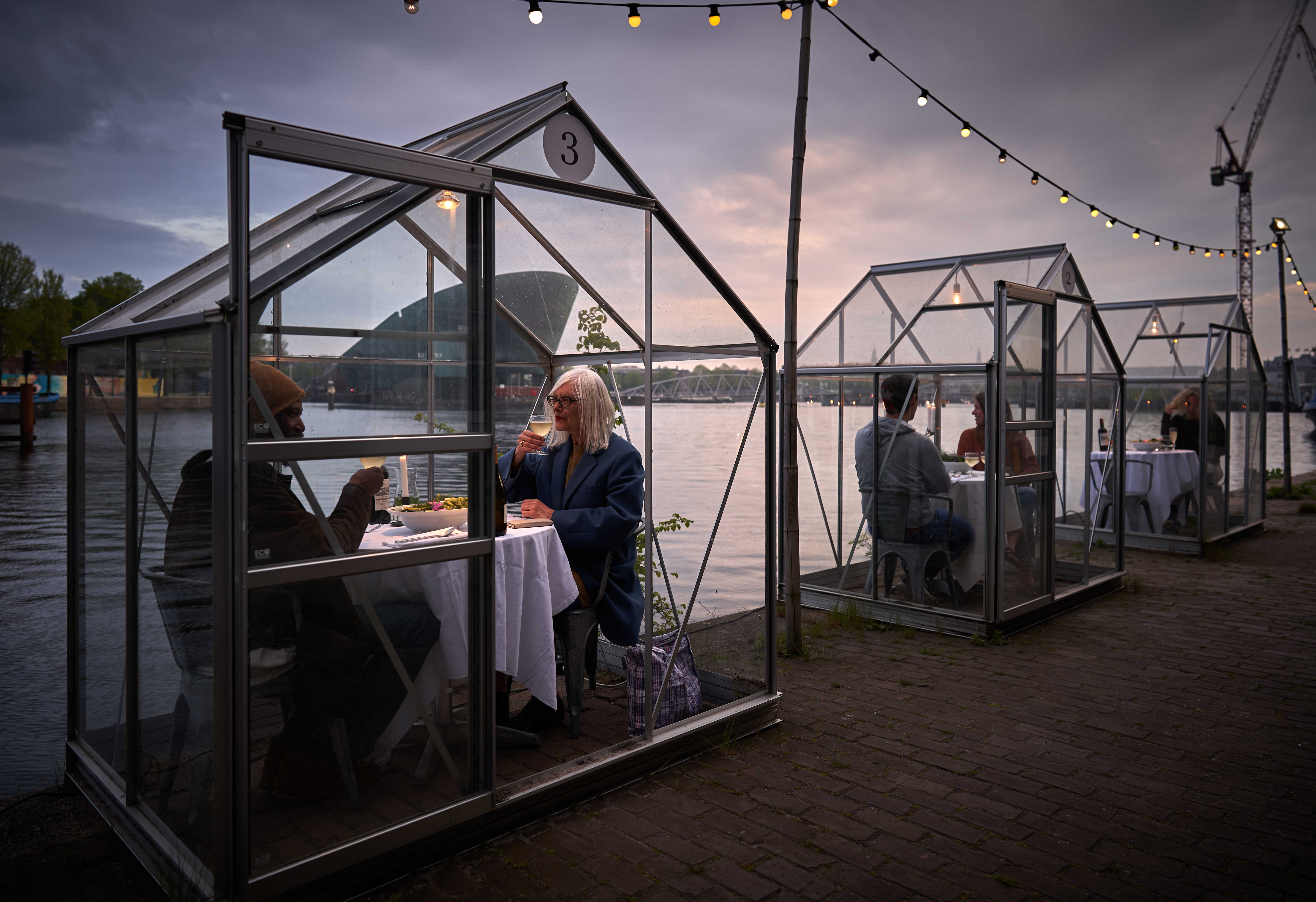
On the harbourfront of Amsterdam, the Netherlands, diners sit in little glasshouses and waiters, wearing protective clothing and visors, proffer food (plant based appropriately) and drinks at the end of long wooden planks to the customers within. This may look like some crazy novelty theme restaurant but it’s a serious attempt to serve meals in the new reality of socially distanced dining.
After a test run with family and friends Mediamatic’s Serres Séparées idea is still awaiting the green light, but it is already booked up until the end of June with people eager to break out of lockdown.
Bettina von Massenbach FCSI of Munich-based OYSTER hospitality management read about the venue’s plans online. “That’s one thing I love about this industry, it is so creative,” she says.
She is well aware of the challenges facing restaurants trying to operate within guidelines suggesting 1.5 or 2 metres between tables. “We must have more intense hygiene standards. There need to be more contactless solutions. I don’t want to be holding a menu in my hands that has been handled by other people. But the question of the amount of people allowed into the restaurants, that’s going to be tricky,” she says.
“I read about one restaurateur in London who said keeping two metres between diners would be like having a single chair in a football stadium. It would kill the atmosphere, there’d be no point going out.”
In Sweden, an enterprising couple have set up a table and single chair in the middle of a beautiful meadow next to their home. They serve a three-course menu, delivered in a basket on a pulley system. Bookings have come from across Sweden and even as far as Japan from diners nervous of encountering strangers.
Not only would the extra space required make eating out a bit of a lonely experience, limiting customers comes at a cost. “For restauranteurs, there’d be 40% drop in revenue, there’d be no point opening up. That’s what some are saying right now,” says von Massenbach.
Staged openings
This is also noted in a recent report from PwC, Where Next for Travel and Leisure?, which discusses the consequences of lockdown on this sector. “In several ways, reopening will be more challenging for businesses than the current lockdown. For many, it may prove easier to conserve cash while a business is closed than when it reopens. With many travel and leisure businesses operating on tight margins, a 10% to 20% drop in sales could put them in financial trouble, even before including the added costs of cleaning, personal protective equipment (PPE) and social distancing.
“Owners will need to plan to reopen carefully, possibly by considering staged openings over time. Operating models and propositions may need to change in the short and medium term to optimise performance. Examples could include limiting menu options in food-to-go operations to simplify kitchen processes and reduce wastage or reducing the destination or hotel coverage for OTAs to focus marketing and contract negotiations on key areas.”
Feelgood factor
Creating a cosy restaurant ambiance is definitely going to be difficult. Tom Howe, operations manager of Jimmy Garcia Catering in London has given the issue some thought for when restrictions in England are lifted. “We are hoping that people will be allowed to select their “bubble” and come out together when lockdown is eased,” he says. “We are looking at something more interactive for people, such as Korean barbecue, people will be ready to be sociable. They may also be looking for something they can’t do at home, such as pizza from a wood-fired oven.”
Jimmy Garcia catering operated the Southbank pop-up in London last Christmas, which featured a series of igloo-type pods where up to 10 people can wine and dine. “We are definitely thinking about how we can use the igloos for socially distant dining, probably instead of the indoor restaurant,” says Howe. “Only one party per pod, although everything is up in the air at the moment until the government has decided what we can do.
Looking to the short-term future Howe is focusing on street food. “I think people will be more comfortable, at first, being outside rather than inside,” he says.
This is borne out by the authorities in Bavaria, Germany, where von Massenbach is based. At the time of writing they had indicated that outdoor operations such as beer gardens, would be able to open on 18 May. However, this may change in light of a perceived increase in the infection rate since a loosening of restrictions across Germany on 4 May.
Protecting staff
Apart from the importance of ensuring customers are safe hospitality venues have a duty to safeguard staff members. Howe expects his operation will have a dedicated server for each party and will have table service at the bar, instead of customers ordering direct from a bartender. This will involve extra cost, but he hopes it would be short term.
Back of house, von Massenbach explains how a small space can offer a safe working environment for chefs and kitchen staff. “It can be manageable by reducing the menu drastically. That’s what I’m suggesting to my clients at the moment, start with a small offer, then the kitchen will be able to cope,” she says.
When asked if that will be enough to get customers to come flocking, von Massenbach laughs: “People will be so pleased to be eating and drinking something outside their homes they won’t really care about a complex menu.”
Jacquetta Picton
Picture credit: Willem Velthoven, Mediamatic (all rights reserved)
